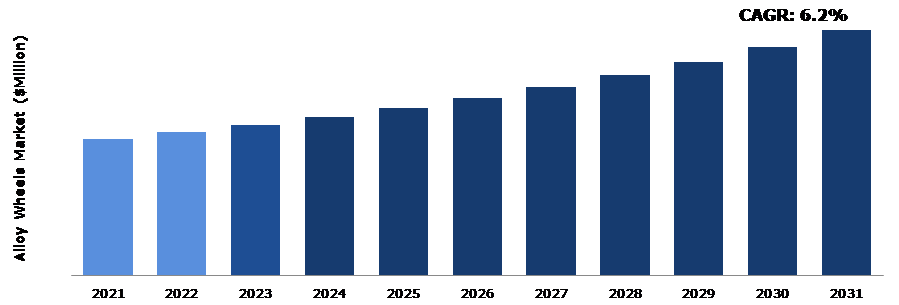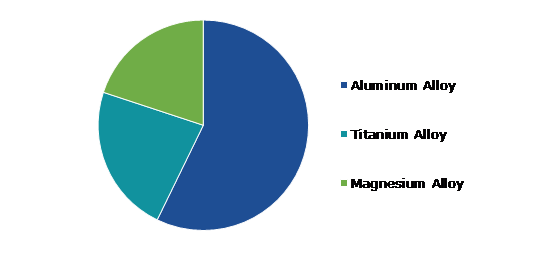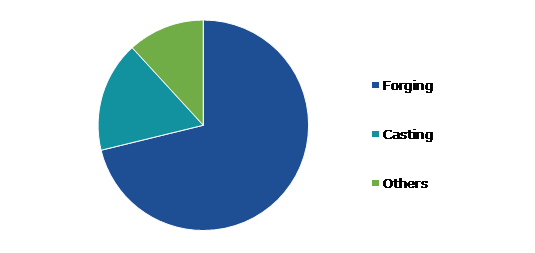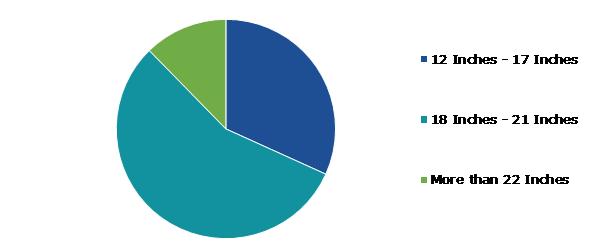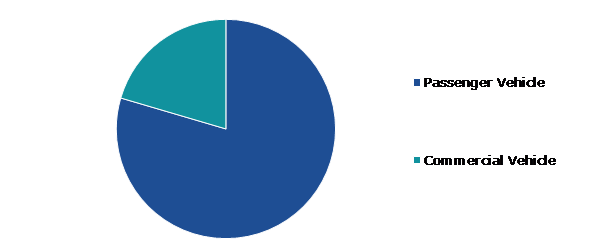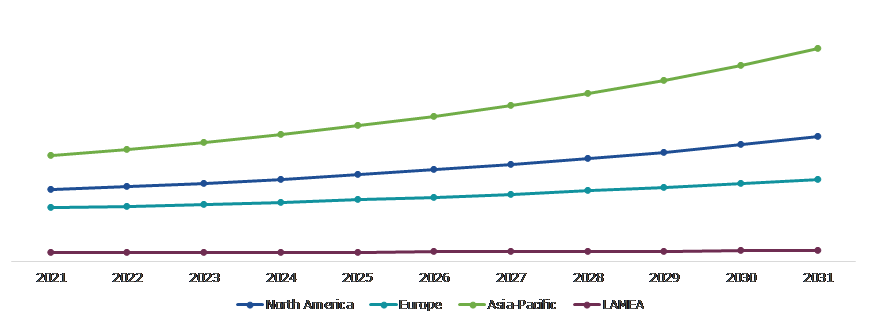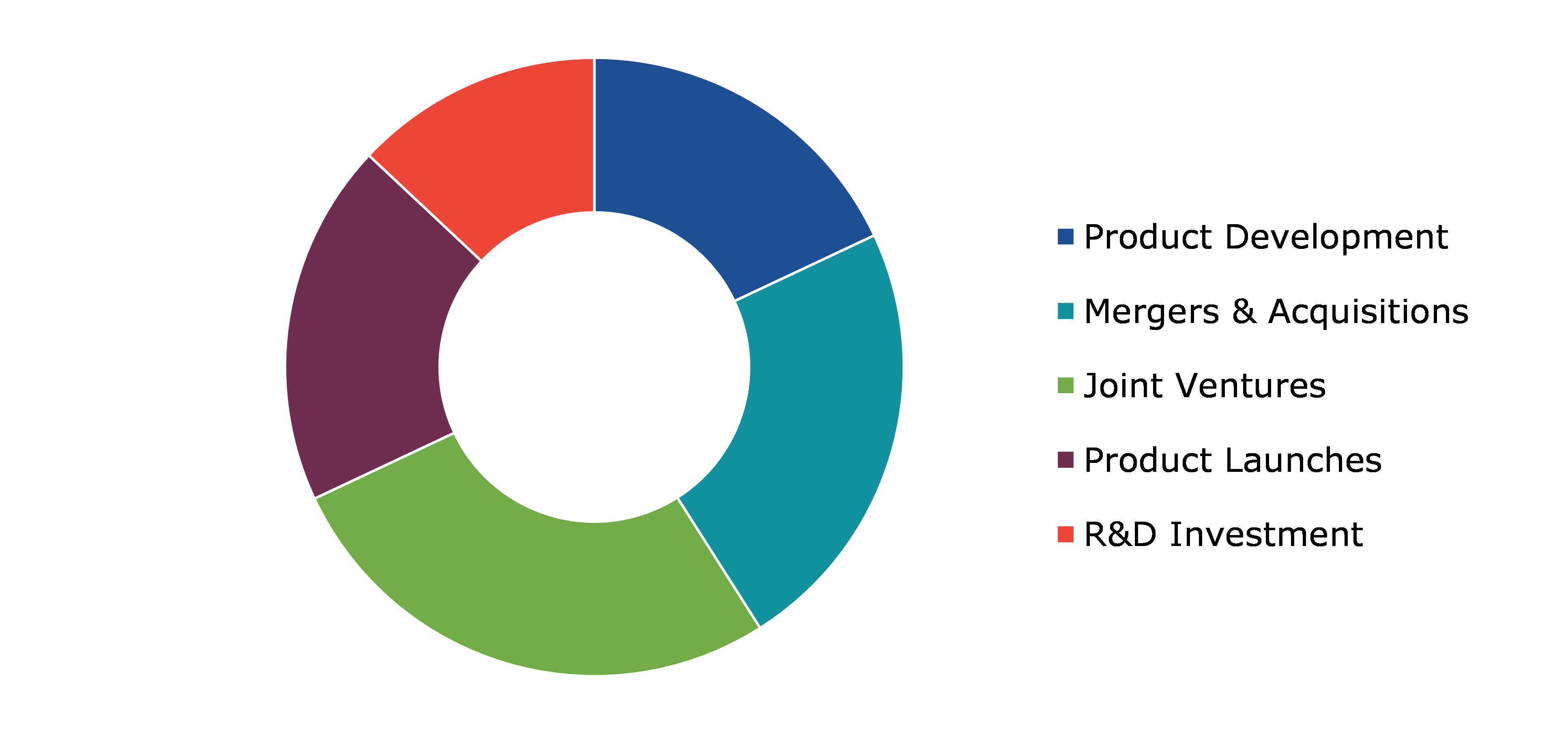Alloy Wheels Market Report
RA08617
Alloy Wheels Market by Material Type (Aluminum Alloy, Titanium Alloy, and Magnesium Alloy), Type (Forging, Casting, and Others), Rim Size (12 Inches - 17 Inches, 18 Inches - 21 Inches, and More than 22 Inches), Vehicle Type (Passenger Vehicle and Commercial Vehicle), and Regional Analysis (North America, Europe, Asia-Pacific, and LAMEA): Global Opportunity Analysis and Industry Forecast, 2022-2031
Global Alloy Wheels Market Analysis
The Global Alloy Wheels Market Size was $17,600 million in 2021 and is predicted to grow with a CAGR of 6.2%, by generating a revenue of $31,568.2 million by 2031.
Global Alloy Wheels Market Synopsis
The growth of the alloy wheels market has been largely driven by technological advancements in manufacturing processes. With the advent of modern technologies, manufacturers are now able to produce high-quality alloy wheels with greater efficiency and accuracy. This has led to an increase in demand for alloy wheels, as consumers are more likely to purchase a product that is both durable and visually appealing. One major advancement in manufacturing processes has been the use of computer-aided design (CAD) and computer-aided manufacturing (CAM) technologies. These technologies have allowed manufacturers to produce alloy wheels with intricate designs and precise specifications, while also reducing the cost of production. Additionally, the use of robotics and automation in the manufacturing process has increased the speed and accuracy of production, leading to increased efficiency and reduced production times. These factors are anticipated to boost the alloy wheels market growth in the upcoming years.
However, the complex process also increases the risk of production errors, leading to defective or sub-par products that need to be scrapped or reworked. This further drives up costs and reduces the overall efficiency of the manufacturing process. Additionally, the need for specialized machinery and skilled labor also makes the production of alloy wheels more challenging, leading to increased production time and higher costs. The higher costs associated with the production of alloy wheels can also make it difficult for smaller players in the market to compete with established brands, reducing the overall competitiveness of the alloy wheels market size.
The increasing use of alloy wheels in the luxury and high-performance vehicles is anticipated to offer excellent opportunities. This is because alloy wheels are cost-effective as well as in Asia-Pacific, countries like China, India, and Japan are witnessing a significant increase in demand for luxury vehicles, thereby providing ample growth opportunities for the alloy wheels market. The growth of the automotive industry in the region has led to an increase in the production of vehicles, thereby creating a huge demand for alloy wheels. The increasing demand for luxury and high-performance vehicles in emerging markets is expected to drive the growth of the alloy wheels market in these regions, thereby providing ample growth for alloy wheels market opportunities for market players.
According to regional analysis, the Asia-Pacific alloy wheels market accounted for the highest market share in 2021. The Asia-Pacific region is expected to be the largest market for alloy wheels due to the growing automotive industry in countries like China, India, and Japan. The market is expected to continue its growth trajectory in the coming years due to the increasing demand for high-performance vehicles and the trend towards personalized mobility solutions.
Alloy Wheels Overview
Automobile wheels constructed of an alloy of aluminum, carbon epoxy, E-glass epoxy, glass epoxy, titanium, and magnesium are called alloy wheels. Alloy wheels are different from regular steel wheels due to their lighter weight as well as attractiveness and enhances the speed of the vehicle. The control of a car can be greatly improved with lightweight wheels such as alloy wheels. Aluminum alloy, which is more durable, is increasingly used to make alloy wheels.
COVID-19 Impact on Global Alloy Wheels Market
The COVID-19 pandemic has brought several uncertainties leading to severe economic losses as various businesses across the world were at a standstill. This has ultimately lowered the demand in the alloy wheels market due to disruptions in supply chain, closure of manufacturing plants, as well as economic slowdown across several countries. In addition, the import-export restrictions were laid down. Factors such as decreasing vehicle sales, temporary shutdowns of manufacturing facilities and raw material suppliers, and border closures have caused disruptions in the supply chain. In addition, the construction & automotive sector faced the highest impact in terms of sales and acquisition of new projects due to which the alloy wheels demand reduced significantly. However, disruptions in the exports of automotive parts from China as well as closure of automotive assembly and manufacturing units have hampered the alloy wheels market share during the pandemic. As the situation returns to normal, the market is likely to recover and increase significantly throughout the forecast period. The increasing penetration of alloy wheels in mid-spec car models globally, as well as the introduction of diamond-cut/dual-tone alloy wheels as standard even in economic variants of car models in developing countries such as India, are expected to drive the alloy wheels market over the forecast period. These initiatives are predicted to drive the alloy wheels market size during the analysis timeframe.
Growing Demand for Fuel-efficient Vehicles and Weight Reduction Sector to Drive the Market Growth
The growing demand for fuel-efficient vehicles has a major role in driving the alloy wheels market. With the increasing focus on reducing carbon emissions, automakers are investing in lightweight components that help to improve fuel efficiency. Alloy wheels are made of a combination of aluminum and other metals, which are lighter in weight than traditional steel wheels. This reduction in weight results in lower fuel consumption, which makes vehicles more environmentally friendly. Furthermore, a factor contributing to the growth of the alloy wheels market is the growing trend toward weight reduction in vehicles. Automakers are increasingly looking for ways to reduce the weight of their vehicles to improve fuel efficiency, performance, and handling. Alloy wheels are a popular choice for weight reduction as they offer a high strength-to-weight ratio and are lighter than steel wheels. Additionally, alloy wheels are also more aesthetically appealing, which has added to their popularity among consumers. The growing demand for fuel-efficient and lightweight vehicles is driving the demand for alloy wheels in the automotive industry.
To know more about global alloy wheels market drivers, get in touch with our analysts here.
High Cost of Alloy Wheels to Restrain the Market Growth
The high cost of alloy wheels can make them a less attractive option for budget-conscious consumers who may prioritize affordability over aesthetics and performance. Furthermore, the cost of alloy wheels can be prohibitive for those who are looking to upgrade their vehicle. Moreover, the limitation is that not all vehicles are equipped to handle the added weight of alloy wheels, which can lead to suspension or tire problems and additional costs. Furthermore, some high-performance vehicles may require specific and more expensive alloy wheels designs to ensure proper performance and handling, which is anticipated to hamper the alloy wheels market growth.
Use of Alloy wheels as an increase of the automotive industry to Drive Excellent Opportunities
Alloy wheels are popular among car enthusiasts as they not only enhance the aesthetics of the vehicle but also provide improved performance, fuel efficiency, and reduced weight. Also, the growth of the automotive industry in emerging economies, such as China, India, and Brazil, has also created a huge demand for alloy wheels in these regions. Moreover, the trend of personalizing vehicles has also driven the demand for customized alloy wheels. In addition, the increasing demand for green vehicles and the trend toward reducing carbon emissions have increased the demand for lightweight alloy wheels, which help reduce fuel consumption and emissions. This presents a huge opportunity for manufacturers to develop eco-friendly alloy wheels and cater to the growing demand. Moreover, the growing automotive industry presents a significant opportunity for manufacturers to tap into the increasing demand for alloy wheels market share.
To know more about global alloy wheels market opportunities, get in touch with our analysts here.
Global Alloy Wheels Market, by Material Type
Based on material type, the market has been divided into aluminum alloy, titanium alloy, and magnesium alloy. Among these, the aluminum alloy sub-segment accounted for the highest market share in 2021 as well as this segment is estimated to show the fastest growth during the forecast period.
Global Alloy Wheels Market Size, by Material Type, 2021
Source: Research Dive Analysis
The Aluminum Alloy sub-type had a dominant market share in 2021 and also is anticipated to show the fastest growth in 2031. Aluminum alloy involves materials such as aluminum alloy, magnesium alloy, and others. Manufacturers of alloy wheels are increasingly focused on reducing automobile weight and lowering the amount of exhaust emission. Furthermore, the popularity of alloy wheels has increased in the previous few years. Previously, motorcycle manufacturers utilized spoke rims, which are still used in some types of motorcycles today. Alloy wheels are chosen because of their great strength and lightweight. Two-wheeler rims/wheels are typically constructed of aluminum, nickel, and other materials, whereas alloys and steel are often used for two-wheeler rims.
Global Alloy Wheels Market, by Type
Based on type, the market has been divided into forging, casting, and others. Among these, the forging sub-segment accounted for highest revenue share in 2021.
Global Alloy Wheels Market Share, by Type, 2021
Source: Research Dive Analysis
The Forging sub-segment had a dominant market share in 2021. The forging process makes these wheels stronger, more durable, and resistant to corrosion and oxidation. Furthermore, the structural integrity of the wheels is maintained. Forged wheels improve overall vehicle performance and fuel efficiency. Forged aluminum is strong, making it the best choice when aluminum components must demonstrate maximum strength and performance while being lightweight. Forging reduces internal voids/gas pockets that weaken metal components, resulting in greater chemical consistency and increased structural strength. Forging promotes optimum grain flow direction, optimizing fatigue resistance and increasing impact strength. These factors are anticipated to boost the growth of forging sub-segment during the analysis timeframe.
Global Alloy Wheels Market, by Rim Size
Based on rim size, the market has been divided into 12 inches - 17 inches, 18 inches - 21 inches, and more than 22 inches. Among these, the 18 inches - 21 inches sub-segment accounted for highest revenue share in 2021.
Global Alloy Wheels Market Growth, by Rim Size, 2021
Source: Research Dive Analysis
The18 inches–21 inches sub-segment had a dominant market share in 2021. The main advantage of the 18- to 21-inch low-profile tires is improved handling in curves. This is because the tire's compound makes it stickier, and the tire's reduced flexibility makes the steering tighter and more trustworthy when running around bends. They can provide you with more control. Because 18- to 21-inch tires usually have a narrower sidewall, they keep considerably more stiffness on the road. The increased stiffness may provide drivers of some automobiles with slightly improved cornering handling. These factors are anticipated to boost the growth of 18 inches–21 inches sub-segment during the analysis timeframe.
Global Alloy Wheels Market, by Vehicle Type
Based on vehicle type, the market has been divided into passenger vehicle and commercial vehicle. Among these, the passenger vehicle sub-segment accounted for highest revenue share in 2021.
Global Alloy Wheels Market Analysis, by Vehicle Type, 2021
Source: Research Dive Analysis
The Passenger Vehicle sub-segment accounted for a dominant market share in 2021. The rising demand for passenger cars in both emerging and developed markets, the passenger vehicle category is expected to be dominant during the forecast period. The global market has been divided into OEM and aftermarket sectors based on the sales channel. Because of the existence of different OEMs in developed nations, as well as the availability of a large customer base, the OEM segment is expected to dominate throughout the projection period. Additionally, OEMs are increasingly motivated to expand automobile wheels production operations in rising markets such as China, India, Mexico, and Brazil. These factors are anticipated to boost the growth of passenger vehicle sub-segment during the analysis timeframe.
Global Alloy Wheels Market, Regional Insights
The alloy wheels market was investigated across North America, Europe, Asia-Pacific, and LAMEA.
Global Alloy Wheels Market Size & Forecast, by Region, 2021-2031 (USD Million)
Source: Research Dive Analysis
The Market for Alloy Wheels Market in Asia-Pacific to be the Most Dominant
The Asia-Pacific alloy wheels market accounted for highest market share in 2021. The increase in automobile sales in the Asia-Pacific region has led to an increase in demand for alloy wheels market size. The growing demand in countries like China, India, and South Korea has boosted the demand for high-end vehicles, and in turn, the demand for alloy wheels. The trend for aftermarket customization and personalization of vehicles has also increased the demand for alloy wheels in the region. With the increasing purchasing power, consumers are opting for premium and stylish alloy wheels that offer improved performance, fuel efficiency, and better handling. The Asia-Pacific region is expected to continue to grow in terms of automobile sales, and this growth is expected to drive the demand for alloy wheels in the region. Companies such as BBS, Enkei, and RAYS Co. Ltd are investing heavily in the region to cater to the growing demand for alloy wheels. With the increasing popularity of electric vehicles, the demand for lightweight and durable alloy wheels is expected to increase further, providing opportunities for manufacturers to expand their business in the region.
Competitive Scenario in the Global Alloy Wheels Market
Investment and agreement are common strategies followed by major market players. For instance, in March 2021 –Ronal Group had launched the Ronal R67 application wheels. The new wheels design incorporates five thin spokes and five different double spokes that are bonded with vibrant design components. Aero-style coatings in red (Tornado Red) or anthracite (Track Grey) provide optimal air intake and provide a sporty touch.
Source: Research Dive Analysis
Some of the leading alloy wheels market players are Steel Strips Wheels Limited, Status Wheels, RONAL GROUP, CMWheels, MHT Luxury Wheels, Enkei International, Inc., BORBET GmbH, Maxion Wheels, UNIWHEELSS Group, Superior Industries, and Others.
| Aspect | Particulars |
| Historical Market Estimations | 2019-2020 |
| Base Year for Market Estimation | 2021 |
| Forecast Timeline for Market Projection | 2022-2031 |
| Geographical Scope | North America, Europe, Asia-Pacific, and LAMEA |
| Segmentation by Material Type |
|
| Segmentation by Type |
|
| Segmentation by Rim Size |
|
| Segmentation by Vehicle Type |
|
| Key Companies Profiled |
|
Q1. What is the size of the global alloy wheels market?
A. The size of the global alloy wheels market was over $17,600 million in 2021 and is projected to reach $31,568.2 million by 2031.
Q2. Which are the major companies in the alloy wheels market?
A. Steel Strips Wheels Limited, Status Wheels, and CMWheels are some of the key players in the global alloy wheels market.
Q3. Which region, among others, possesses greater investment opportunities in the near future?
A. The Asia-Pacific region possesses great investment opportunities for investors to witness the most promising growth in the future.
Q4. What will be the growth rate of the Asia-Pacific alloy wheels market?
A. Asia-Pacific alloy wheels market is anticipated to grow at 7.4% CAGR during the forecast period.
Q5. What are the strategies opted by the leading players in this market?
A. Agreement and investment are the two key strategies opted by the operating companies in this market.
Q6. Which companies are investing more on R&D practices?
A. Superior Industries, BORBET GmbH, and MHT Luxury Wheels are the companies investing more on R&D activities for developing new products and technologies.
1.Research Methodology
1.1.Desk Research
1.2.Real time insights and validation
1.3.Forecast model
1.4.Assumptions and forecast parameters
1.5.Market size estimation
1.5.1.Top-down approach
1.5.2.Bottom-up approach
2.Report Scope
2.1.Market definition
2.2.Key objectives of the study
2.3.Report overview
2.4.Market segmentation
2.5.Overview of the impact of COVID-19 on the global alloy wheels market
3.Executive Summary
4.Market Overview
4.1.Introduction
4.2.Growth impact forces
4.2.1.Drivers
4.2.2.Restraints
4.2.3.Opportunities
4.3.Market value chain analysis
4.3.1.List of raw material suppliers
4.3.2.List of manufacturers
4.3.3.List of distributors
4.4.Innovation & sustainability matrices
4.4.1.Technology matrix
4.4.2.Regulatory matrix
4.5.Porter’s five forces analysis
4.5.1.Bargaining power of suppliers
4.5.2.Bargaining power of consumers
4.5.3.Threat of substitutes
4.5.4.Threat of new entrants
4.5.5.Competitive rivalry intensity
4.6.PESTLE analysis
4.6.1.Political
4.6.2.Economical
4.6.3.Social
4.6.4.Technological
4.6.5.Environmental
4.7.Impact of COVID-19 on the alloy wheels market
4.7.1.Pre-covid market scenario
4.7.2.Post-covid market scenario
5.Alloy Wheels Market Analysis, by Material Type
5.1.Overview
5.2.Aluminum Alloy
5.2.1.Definition, key trends, growth factors, and opportunities
5.2.2.Market size analysis, by region, 2021-2031
5.2.3.Market share analysis, by country, 2021-2031
5.3.Titanium Alloy
5.3.1.Definition, key trends, growth factors, and opportunities
5.3.2.Market size analysis, by region, 2021-2031
5.3.3.Market share analysis, by country, 2021-2031
5.4.Magnesium Alloy
5.4.1.Definition, key trends, growth factors, and opportunities
5.4.2.Market size analysis, by region, 2021-2031
5.4.3.Market share analysis, by country, 2021-2031
5.5.Research Dive Exclusive Insights
5.5.1.Market attractiveness
5.5.2.Competition heatmap
6.Alloy Wheels Market Analysis, by Type
6.1.Forging
6.1.1.Definition, key trends, growth factors, and opportunities
6.1.2.Market size analysis, by region, 2021-2031
6.1.3.Market share analysis, by country, 2021-2031
6.2.Casting
6.2.1.Definition, key trends, growth factors, and opportunities
6.2.2.Market size analysis, by region, 2021-2031
6.2.3.Market share analysis, by country, 2021-2031
6.3.Others
6.3.1.Definition, key trends, growth factors, and opportunities
6.3.2.Market size analysis, by region, 2021-2031
6.3.3.Market share analysis, by country, 2021-2031
6.4.Research Dive Exclusive Insights
6.4.1.Market attractiveness
6.4.2.Competition heatmap
7.Alloy Wheels Market Analysis, by Rim Size
7.1.12 Inches - 17 Inches
7.1.1.Definition, key trends, growth factors, and opportunities
7.1.2.Market size analysis, by region, 2021-2031
7.1.3.Market share analysis, by country, 2021-2031
7.2.18 Inches - 21 Inches
7.2.1.Definition, key trends, growth factors, and opportunities
7.2.2.Market size analysis, by region, 2021-2031
7.2.3.Market share analysis, by country, 2021-2031
7.3.More than 22 Inches
7.3.1.Definition, key trends, growth factors, and opportunities
7.3.2.Market size analysis, by region, 2021-2031
7.3.3.Market share analysis, by country, 2021-2031
7.4.Research Dive Exclusive Insights
7.4.1.Market attractiveness
7.4.2.Competition heatmap
8.Alloy Wheels Market Analysis, by Vehicle Type
8.1.Passenger Vehicle
8.1.1.Definition, key trends, growth factors, and opportunities
8.1.2.Market size analysis, by region, 2021-2031
8.1.3.Market share analysis, by country, 2021-2031
8.2.Commercial Vehicle
8.2.1.Definition, key trends, growth factors, and opportunities
8.2.2.Market size analysis, by region, 2021-2031
8.2.3.Market share analysis, by country, 2021-2031
8.3.Research Dive Exclusive Insights
8.3.1.Market attractiveness
8.3.2.Competition heatmap
9.Alloy Wheels Market, by Region
9.1.North America
9.1.1.U.S.
9.1.1.1.Market size analysis, by Material Type, 2021-2031
9.1.1.2.Market size analysis, by Type, 2021-2031
9.1.1.3.Market size analysis, by Rim Size, 2021-2031
9.1.1.4.Market size analysis, by Vehicle Type, 2021-2031
9.1.2.Canada
9.1.2.1.Market size analysis, by Material Type, 2021-2031
9.1.2.2.Market size analysis, by Type, 2021-2031
9.1.2.3.Market size analysis, by Rim Size, 2021-2031
9.1.2.4.Market size analysis, by Vehicle Type, 2021-2031
9.1.3.Mexico
9.1.3.1.Market size analysis, by Material Type, 2021-2031
9.1.3.2.Market size analysis, by Type, 2021-2031
9.1.3.3.Market size analysis, by Rim Size, 2021-2031
9.1.3.4.Market size analysis, by Vehicle Type, 2021-2031
9.1.4.Research Dive Exclusive Insights
9.1.4.1.Market attractiveness
9.1.4.2.Competition heatmap
9.2.Europe
9.2.1.Germany
9.2.1.1.Market size analysis, by Material Type, 2021-2031
9.2.1.2.Market size analysis, by Type, 2021-2031
9.2.1.3.Market size analysis, by Rim Size, 2021-2031
9.2.1.4.Market size analysis, by Vehicle Type, 2021-2031
9.2.2.UK
9.2.2.1.Market size analysis, by Material Type, 2021-2031
9.2.2.2.Market size analysis, by Type, 2021-2031
9.2.2.3.Market size analysis, by Rim Size, 2021-2031
9.2.2.4.Market size analysis, by Vehicle Type, 2021-2031
9.2.3.France
9.2.3.1.Market size analysis, by Material Type, 2021-2031
9.2.3.2.Market size analysis, by Type, 2021-2031
9.2.3.3.Market size analysis, by Rim Size, 2021-2031
9.2.3.4.Market size analysis, by Vehicle Type, 2021-2031
9.2.4.Spain
9.2.4.1.Market size analysis, by Material Type, 2021-2031
9.2.4.2.Market size analysis, by Type, 2021-2031
9.2.4.3.Market size analysis, by Rim Size, 2021-2031
9.2.4.4.Market size analysis, by Vehicle Type, 2021-2031
9.2.5.Italy
9.2.5.1.Market size analysis, by Material Type, 2021-2031
9.2.5.2.Market size analysis, by Type, 2021-2031
9.2.5.3.Market size analysis, by Rim Size, 2021-2031
9.2.5.4.Market size analysis, by Vehicle Type, 2021-2031
9.2.6.Rest of Europe
9.2.6.1.Market size analysis, by Material Type, 2021-2031
9.2.6.2.Market size analysis, by Type, 2021-2031
9.2.6.3.Market size analysis, by Rim Size, 2021-2031
9.2.6.4.Market size analysis, by Vehicle Type, 2021-2031
9.2.7.Research Dive Exclusive Insights
9.2.7.1.Market attractiveness
9.2.7.2.Competition heatmap
9.3.Asia-Pacific
9.3.1.China
9.3.1.1.Market size analysis, by Material Type, 2021-2031
9.3.1.2.Market size analysis, by Type, 2021-2031
9.3.1.3.Market size analysis, by Rim Size, 2021-2031
9.3.1.4.Market size analysis, by Vehicle Type, 2021-2031
9.3.2.Japan
9.3.2.1.Market size analysis, by Material Type, 2021-2031
9.3.2.2.Market size analysis, by Type, 2021-2031
9.3.2.3.Market size analysis, by Rim Size, 2021-2031
9.3.2.4.Market size analysis, by Vehicle Type, 2021-2031
9.3.3.India
9.3.3.1.Market size analysis, by Material Type, 2021-2031
9.3.3.2.Market size analysis, by Type, 2021-2031
9.3.3.3.Market size analysis, by Rim Size, 2021-2031
9.3.3.4.Market size analysis, by Vehicle Type, 2021-2031
9.3.4.Australia
9.3.4.1.Market size analysis, by Material Type, 2021-2031
9.3.4.2.Market size analysis, by Type, 2021-2031
9.3.4.3.Market size analysis, by Rim Size, 2021-2031
9.3.4.4.Market size analysis, by Vehicle Type, 2021-2031
9.3.5.South Korea
9.3.5.1.Market size analysis, by Material Type, 2021-2031
9.3.5.2.Market size analysis, by Type, 2021-2031
9.3.5.3.Market size analysis, by Rim Size, 2021-2031
9.3.5.4.Market size analysis, by Vehicle Type, 2021-2031
9.3.6.Rest of Asia-Pacific
9.3.6.1.Market size analysis, by Material Type, 2021-2031
9.3.6.2.Market size analysis, by Type, 2021-2031
9.3.6.3.Market size analysis, by Rim Size, 2021-2031
9.3.6.4.Market size analysis, by Vehicle Type, 2021-2031
9.3.7.Research Dive Exclusive Insights
9.3.7.1.Market attractiveness
9.3.7.2.Competition heatmap
9.4.LAMEA
9.4.1.Brazil
9.4.1.1.Market size analysis, by Material Type, 2021-2031
9.4.1.2.Market size analysis, by Type, 2021-2031
9.4.1.3.Market size analysis, by Rim Size, 2021-2031
9.4.1.4.Market size analysis, by Vehicle Type, 2021-2031
9.4.2.Saudi Arabia
9.4.2.1.Market size analysis, by Material Type, 2021-2031
9.4.2.2.Market size analysis, by Type, 2021-2031
9.4.2.3.Market size analysis, by Rim Size, 2021-2031
9.4.2.4.Market size analysis, by Vehicle Type, 2021-2031
9.4.3.UAE
9.4.3.1.Market size analysis, by Material Type, 2021-2031
9.4.3.2.Market size analysis, by Type, 2021-2031
9.4.3.3.Market size analysis, by Rim Size, 2021-2031
9.4.3.4.Market size analysis, by Vehicle Type, 2021-2031
9.4.4.South Africa
9.4.4.1.Market size analysis, by Material Type, 2021-2031
9.4.4.2.Market size analysis, by Type, 2021-2031
9.4.4.3.Market size analysis, by Rim Size, 2021-2031
9.4.4.4.Market size analysis, by Vehicle Type, 2021-2031
9.4.5.Rest of LAMEA
9.4.5.1.Market size analysis, by Material Type, 2021-2031
9.4.5.2.Market size analysis, by Type, 2021-2031
9.4.5.3.Market size analysis, by Rim Size, 2021-2031
9.4.5.4.Market size analysis, by Vehicle Type, 2021-2031
9.4.6.Research Dive Exclusive Insights
9.4.6.1.Market attractiveness
9.4.6.2.Competition heatmap
10.Competitive Landscape
10.1.Top winning strategies, 2021
10.1.1.By strategy
10.1.2.By year
10.2.Strategic overview
10.3.Market share analysis, 2021
11.Company Profiles
11.1.Steel Strips Wheels Limited
11.1.1.Overview
11.1.2.Business segments
11.1.3.Product portfolio
11.1.4.Financial performance
11.1.5.Recent developments
11.1.6.SWOT analysis
11.2.Status Wheel
11.2.1.Overview
11.2.2.Business segments
11.2.3.Product portfolio
11.2.4.Financial performance
11.2.5.Recent developments
11.2.6.SWOT analysis
11.3.RONAL GROUP
11.3.1.Overview
11.3.2.Business segments
11.3.3.Product portfolio
11.3.4.Financial performance
11.3.5.Recent developments
11.3.6.SWOT analysis
11.4.CMWheels
11.4.1.Overview
11.4.2.Business segments
11.4.3.Product portfolio
11.4.4.Financial performance
11.4.5.Recent developments
11.4.6.SWOT analysis
11.5.MHT Luxury Wheels
11.5.1.Overview
11.5.2.Business segments
11.5.3.Product portfolio
11.5.4.Financial performance
11.5.5.Recent developments
11.5.6.SWOT analysis
11.6.Enkei International, Inc.
11.6.1.Overview
11.6.2.Business segments
11.6.3.Product portfolio
11.6.4.Financial performance
11.6.5.Recent developments
11.6.6.SWOT analysis
11.7.BORBET GmbH
11.7.1.Overview
11.7.2.Business segments
11.7.3.Product portfolio
11.7.4.Financial performance
11.7.5.Recent developments
11.7.6.SWOT analysis
11.8.Maxion Wheels
11.8.1.Overview
11.8.2.Business segments
11.8.3.Product portfolio
11.8.4.Financial performance
11.8.5.Recent developments
11.8.6.SWOT analysis
11.9.UNIWHEELS Group
11.9.1.Overview
11.9.2.Business segments
11.9.3.Product portfolio
11.9.4.Financial performance
11.9.5.Recent developments
11.9.6.SWOT analysis
11.10.Superior Industries
11.10.1.Overview
11.10.2.Business segments
11.10.3.Product portfolio
11.10.4.Financial performance
11.10.5.Recent developments
11.10.6.SWOT analysis
Alloy wheels are becoming increasingly popular in the automotive industry. Alloy wheels are used in automobiles and are made of an alloy of carbon epoxy, aluminum, e-glass epoxy, titanium, glass epoxy, and magnesium. Alloy wheels differ from normal steel wheels owing to their lighter weight, attractiveness, and ability to increase vehicle speed. The control of a car can be significantly enhanced with lightweight wheels like alloy wheels.
The demand for alloy wheels has been increasing in recent years due to the increasing demand for lightweight and fuel-efficient vehicles. Automobile manufacturers are spending money on lightweight components that help to increase fuel efficiency in response to the growing focus on lowering carbon emissions. In addition, the market for alloy wheels is developing because of the expanding trend for lighter vehicles. Automobile manufacturers are increasingly searching for ways to reduce vehicle weight in order to increase performance, fuel efficiency, and handling. Also, alloy wheels are more aesthetically pleasing, which has increased their popularity among consumers. All these factors are expanding the growth of the global alloy wheels market at a rapid pace.
Newest Insights in the Alloy Wheels Market
The growing adoption of green automobiles, as well as the trend towards lowering carbon emissions, has increased the need for lightweight alloy wheels, which aid in lowering fuel consumption and emissions. As per a report by Research Dive, the global alloy wheels market is anticipated to surpass a revenue of $31,568.2 million in the 2022–2031 timeframe. The Asia-Pacific alloy wheels market is predicted to experience dominant growth in the years to come. This is because the region has a huge demand for alloy wheels due to the rising demand for high-end vehicles, and in turn, the need for alloy wheels in countries like India, China, and South Korea, in the region.
How are Market Players Responding to the Rising Demand for Alloy Wheels?
Market players are expanding their product offerings, improving product quality, increasing production capacity, and collaborating with other market players to stay ahead of the competition. Some of the foremost players in the alloy wheels market are Status Wheels, Steel Strips Wheels Limited, Superior Industries, CMWheels, RONAL GROUP, MHT Luxury Wheels, Enkei International, Inc., Maxion Wheels, BORBET GmbH, UNIWHEELSS Group, and others. These players are focused on implementing strategies such as mergers and acquisitions, novel developments, collaborations, and partnerships to reach a leading position in the global market. For instance:
- In March 2021, Ronal Group, a company that produces wheels for cars and commercial vehicles, launched the Ronal R67 application wheels. With this launch, the company aims to make a prominent position in the automotive wheel industry.
- In January 2023, Wheels India, one of the biggest producers of steel wheels in the world, launched the Flow Form technology in Cast Alloy Wheels, which is among the most modern manufacturing technologies in the wheel industry.
- In February 2023, Royal Enfield, an Indian multinational motorcycle manufacturing firm, announched to launch Royal Enfield 650 Interceptor 650, Continental GT 650 with alloy wheels by March 2023.
COVID-19 Impact on the Global Alloy Wheels Market
The unpredicted rise of the coronavirus pandemic in 2020 adversely impacted the global alloy wheels market. During the pandemic period, the demand for alloy wheels decreased as a result of supply chain disruptions, plant closures, and the global economic downturn. Moreover, import-export limitations were imposed in various countries amidst the pandemic. The supply chain was severely disrupted by factors like temporary shutdowns of raw material suppliers and production facilities, declining auto sales, and border closures. In addition, the construction and automobile industries were most negatively impacted in terms of sales and the acquisition of new projects, which severely decreased the demand for alloy wheels. However, as per market analysts, the alloy wheels market is likely to recover soon in the post-pandemic period.
Personalize this research
- Triangulate with your own data
- Request your format and definition
- Get a deeper dive on a specific application, geography, customer or competitor
- + 1-888-961-4454 Toll - Free
- support@researchdive.com

